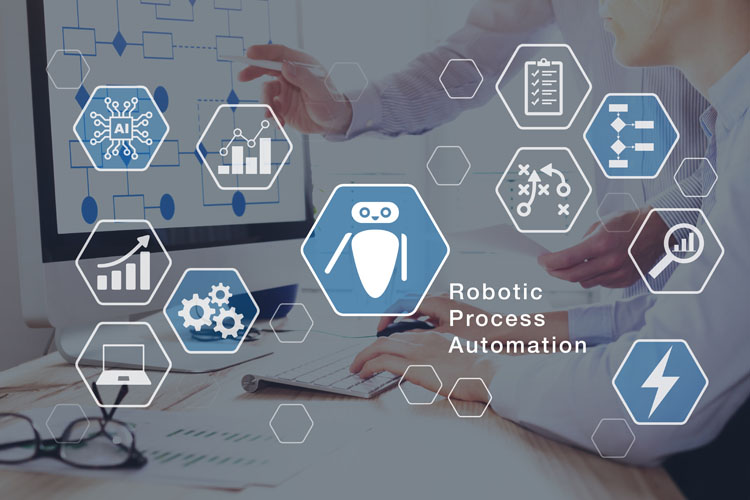What Is RPA Robot?
RPA is a software technique for designing, deploying, and managing software robots that work with digital systems and software to mimic human movements. The term RTA relates to the automation of robotic processes. It's automation software that takes care of time-consuming, manual digital activities and transfers them to a "digital worker." By allowing staff to focus on mission-critical tasks, RPA technologies help businesses, they save time and money and also increase productivity.
Why Do We Need Financial RPA Robots?
Financial RPA Robot is one of today's most fascinating business technologies. While RPA is currently being used in industrial manufacturing in gigantic armatures and robotic fabricators to assemble everything from cars to small plastic components, it is now making its way into the back office as well.
You can automate procedures that traditionally require human workers to undertake laborious intervention by using software "robots" capable of obeying particular rules and action sequences. RPA can be beneficial in a variety of areas inside a company. Two of the most inventive applications of these technologies today are related to the business's beating heart: financial operations and accounting methods.
Do you know what RPA is in finance and accounting? RPA might signify a variety of things depending on the RPA use cases in finance, from automatically auditing financial statements to speeding up the rate at which accounts receivable and payable perform activities. In the financial sector, Financial RPA Robot is defined as the use of robotic applications to supplement (or replace) human operations. Moreover, Financial RPA Robot assists banks and accounting departments in automating repetitive manual operations, allowing employees to focus on more important activities and gaining a competitive advantage for the company.

RPA Use Cases in Finance:
Because no single package can handle all of the necessary activities, managing a company's finances generally necessitates a diversified range of software tools. There is typically a lot of boring, repetitive work—work that is excellent for RPA automation because of the separation of systems.
Some examples of RPA use cases in finance are the following:
Purchase Order Processing: Staff may devote a significant amount of time to processing purchase orders and routing them for approval in order for the company to obtain crucial goods and services. You could set up a software robot with intelligent (or "cognitive") data capture capabilities to scan POs for crucial data, enter it into the proper system, and create an approval request.
Basic Accounts Reconciliation: Comparing the balances on essential company accounts can take up a lot of a clerk's time, as it requires them to log in and out of many systems. Accuracy is necessary for future audits to be successful. Many of the basic aspects of these activities can be handled by RPA robots, with just human input required when data does not align as intended.
Invoice Processing: Invoices, like POs, are a constant source of frustration for back-office workers, especially when they arrive in various formats. This is a process that a robot can easily accomplish, exactly like processing POs.
When data differs significantly from what is expected, or the robot's confidence is on the low end of the spectrum, an invoice can be flagged for manual user review. Outside of these circumstances, you can drastically reduce the amount of "touches" required for each invoice.
Improved Financial Reporting: It's critical to provide correct information to the company's decision-makers, and that information flow necessitates precise and complete reporting. Employees may devote more time to developing the deep data insights needed to make informed decisions now that robots are performing more of the routine finance jobs in the workplace. RPA use cases in finance include Vendor verification and setup, order entry, and Extracting data from invoices and purchase orders.
Benefits of Using RPA in Finance:
Why is Financial RPA Robot such an intriguing technology for so many businesses? Clearly, many duties in accounting, finance, and auditing may be taken partially or entirely out of human hands to make work go faster. However, there are some hazards associated with automation, both in terms of process errors and human morale. RPA, on the other hand, has the opposite effect when correctly deployed and creatively constructed, benefits of RPA in finance are the following:
1. "Work smarter, not harder," as the saying goes. Every employee has complained about tedious procedures like copying and pasting formulas and results from one software to the next. RPA improves staff productivity and job satisfaction. So this also comes in the list of benefits of RPA in finance.
2. Errors can cause delays and cost money, therefore accuracy is critical. RPA ensures precision in procedures at every step when properly set up. Reducing human mistake rates saves money for the company and ensures that critical procedures run smoothly.
3. As technologies mature and develop, deploying RPA now provides the business with a framework to expand its automation footprint in the future. As new prospects for automation emerge, an investment made today could pay off in unforeseen ways.
What Is RPA's main goal?
RPA's goal is to automate repetitive — and presumably dull — corporate operations so that people may focus on more complicated tasks that require advanced problem-solving skills. Furthermore, Financial RPA Robot works for your company 24 hours a day, 7 days a week. RPA should be weighed against other technological options as well as process change management skills. When an organization wishes to work with structured data to automate an existing manual job or process with little process re-engineering, RPA can be used.
Conclusion:
Financial RPA Robot RPA is one of the most exciting business technologies available today. While RPA is already being utilized in industrial manufacturing to build everything from vehicles to small plastic components in enormous armatures and robotic fabricators, it is now making its way into the back office as well.
RPA deployment currently offers the organization a framework to grow its automation footprint in the future as technologies mature and improve. As new possibilities for automation arise, a current investment could pay off in unexpected ways.





